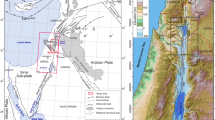Abstract
DURING March–April 1968 and December 1968, a marine magnetic and continuous reflexion (Sparker) survey was carried out simultaneously in the central Irish Sea between 3° 15′–5° 50′ longitude and 52° 40′–53° 35′ latitude. There were enough magnetic data to draw contours at intervals of 25 gamma, after removing the regional, secular and diurnal effects (Fig. 1). In its broad features the map seems consistent with the aeromagnetic map of Great Britain1 and ties on well to the marine magnetic survey of Tremadoc Bay2. Compared with the aeromagnetic map, Fig. 1 emphasizes anomalies of shallow origin. A linear belt of such anomalies, 0.5–1.5 nautical miles wide, stands out to the north-west of Anglesey and extends north-west from the vicinity of Holy head Harbour across the Irish Sea. It consists of highly variable anomalies, with the chief negative anomaly varying between 500 and 150 gamma in amplitude and 180 to 235 m in half-width. The main part of the anomaly can be explained if a steep dyke-like body with a magnetization similar to that of the Tertiary lavas and dykes of Skye3 and Antrim4 is assumed to be running along it. Such a Tertiary body has to be about 70 m wide and − 70 m O.D. near the harbour, deepening north-westwards. The shape of the anomaly suggests that the body may be made up of a group of dykes running parallel in this narrow belt. A similar linear anomaly runs parallel to the south-west coast of Holyhead Isle and may also extend to the southeast parallel to the Anglesey coast. Fig. 1 also shows a broad linear “high” in the extreme north-west of the area, which trends north-east–south-west. This feature has been recorded farther west, off the coast of Ireland, south-east of Dublin Bay5.
Similar content being viewed by others
References
Geological Survey, Aeromagnetic Map of Part of Great Britain and N. Ireland (HMSO, London, 1964).
Griffiths, D. H., King, R. F., and Wilson, C. D. V., Quart. J. Geol. Soc., London, 117, 171 (1961).
Khan, M. A., Geophys. J., 3, 45 (1960).
Hospers, J., and Charlesworth, H. A. C., Mon. Not. Roy. Astron. Soc. Geophys. Suppl., 7, 32 (1954).
Stacey, A. P., thesis, Univ. Durham (1965).
Institute of Geological Sciences, Report No. 69/1 (HMSO, 1969).
Watkins, N. D., thesis, Univ. Birmingham (1958).
Blundell, D. J., Davey, F. J., and Graves, L. J., Nature, 219, 55 (1968).
Bott, M. H. P., in Geology of Shelf Seas (edit. by Donovan, D. T.), 93 (1968).
Wood, A., and Woodland, A. W., Nature, 219, 1352 (1968).
Powell, D. W., Quart. J. Geol. Soc. London, 111, 375 (1956).
Blundell, D. J., King, R. F., and Wilson, C. D. V., Quart. J. Geol. Soc., London, 120, 35 (1964).
Institute of Geological Sciences, Report No. 69/2 (HMSO, 1969).
Author information
Authors and Affiliations
Rights and permissions
About this article
Cite this article
AL-SHAIKH, Z. Geophysical Results from Caernarvon and Tremadoc Bays. Nature 224, 897–899 (1969). https://doi.org/10.1038/224897a0
Received:
Revised:
Issue Date:
DOI: https://doi.org/10.1038/224897a0
- Springer Nature Limited





